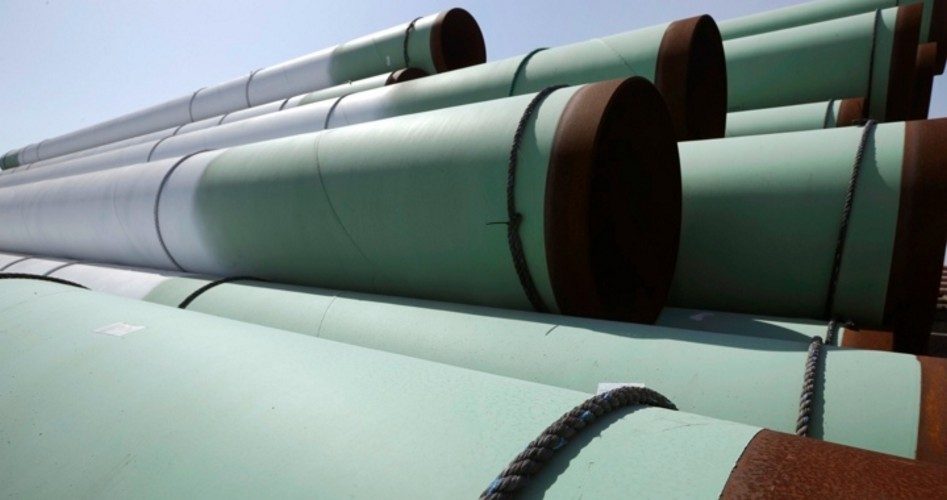
Within days of President Obama’s surprise phone call on November 10, 2011 to Canada’s Prime Minister Stephen Harper telling him that he was going to put approval of the Keystone XL pipeline on interminable hold, Frank McKenna, the former Canadian ambassador to the United States, said: “The best way to get Keystone XL built is to make it irrelevant.”
What’s nearly approved is the plan to send the crude oil that’s pouring out of the Bakken formation at the Keystone Hardisty terminal in Alberta coursing through an underused natural gas pipeline stretching from Hardisty to Québec. From there it’s a relatively short hop to New Brunswick’s Irving oil refinery, where the refined product will easily and efficiently find its way to thirsty countries such as India. The beauty is that, as investigative journalists writing in the Montréal Gazette last week expressed it: “Obama can’t do a single thing about it.”
Although most of the Keystone pipeline has already been built, one strategic link has been deliberately stalled by President Obama in response to complaints from environmentalists that it would negatively impact the environment in Nebraska. There’s a Nebraska lawsuit pending which has given Obama plausible deniability in announcing his delay in approval.
While much of the oil coming out of Hardisty is being piped through Keystone, producers have been forced to move some 160,000 barrels a day to the United States by railroad tank cars. But an administrative agency, signed into law by former President George W. Bush in 2004 — the Pipeline And Hazardous Materials Safety Administration (PHMSA) has just announced that most of those 335,000 tank cars must be retrofitted with thicker steel jackets, heat shields, better brakes, and so forth in order to avoid a repeat of the 2013 Lac-Megantic derailment and explosion that killed 47 people and destroyed half the town.
That such requirements are purely political was exposed by the Wall Street Journal on Monday when it pointed out that, according to the Federal Railroad Administration (FRA), “99.9977% of all potentially dangerous cargo arrives at its destination without incident.” It quoted an Obama-appointed director of the FRA, Joseph Szabo, who confirmed the fact:
Rail has never been safer. As I have said repeatedly, 2012 — by virtually all measures — was the safest year in railroading history, with train accidents down a remarkable 43% in 10 years.
And among the millions of annual shipments of hazardous materials by rail, less than a fraction of 1% of these has resulted in any type of release.
The Journal further faults the PHMSA for demanding retrofitting requirements that would have little impact on an accident such as Lac-Megantic from being repeated:
The most stringent retrofit would prevent tank punctures when a train crashes at 20 mph or less. But all of the major derailments of recent years in Illinois, Ohio and Pennsylvania were traveling much faster — the lead car at Lac-Megantic was moving at 65 mph.
Meantime, the added weight of the fortifications means cars are able to carry fewer gallons, which either creates bottlenecks, or more cars must be added to transport the same amount of product. More and heavier traffic increases wear and deterioration of tracks — thus compounding the risk of an accident.
All of which, concludes the Journal, points to a deliberate attempt to stall oil development:
It’s hard not to conclude that the real motive is to force tens of thousands of tankers off the rails and slow oil and gas development. Workshops and repair facilities are a limited resource and [they] can only handle retrofits for about 6400 cars per year….
By one industry estimate, the plan could bring as much as half of North Dakota’s oil production off-line…
The safety record of the PHMSA is hardly stellar. A 2010 pipeline explosion in San Bruno, California, near San Francisco, killed eight people, injured 58 and destroyed much of a subdivision. Investigators from the National Transportation Safety Board found that weak federal oversight by the PHMSA was partly responsible. And in May this year the Inspector General for the Department of Transportation found that the PHMSA’s internal controls, management and safety training were subpar.
Despite unanimous support for what is called Energy East by all Canadian political parties, the deal is not quite done. Although backers say it has a high probability of being built, the total cost of refurbishing the existing gas line and extending it from Québec to New Brunswick will be more than $10 billion. Once officially approved, it will still take a minimum of three years to get the workaround operational.
It took months of intensive negotiation between TransCanada Corporation and Arthur Irving, the billionaire owner of Irving Oil Ltd., to come to terms. Irving operates Canada’s largest refinery along with 900 service stations in Eastern Canada and New England and at present supplies 60 percent of the greater Boston area’s gasoline.
McKenna was the primary driver of this workaround, floating the idea of doing an end run around Obama in an editorial in Canada’s National Post following his phone call to Harper. From there McKenna galvanized his network of supporters, which resulted in a deal whereby TransCanada will form a 50-50 joint venture with Irving oil with Irving as the operating partner.
Though it’s not a done deal, it’s close enough to conclude that, given sufficient incentive, government regulations and political ideology can be neutralized by those interested in serving customers with their energy needs. In this case, those incentives appear to be sufficient to make Obama’s decision to stall approval of the Keystone XL pipeline irrelevant.
Photo: AP Images
A graduate of Cornell University and a former investment advisor, Bob is a regular contributor to The New American magazine and blogs frequently at www.LightFromTheRight.com, primarily on economics and politics. He can be reached at [email protected]



